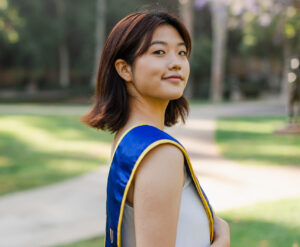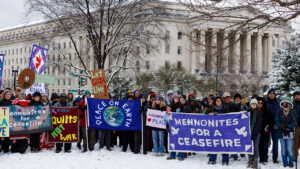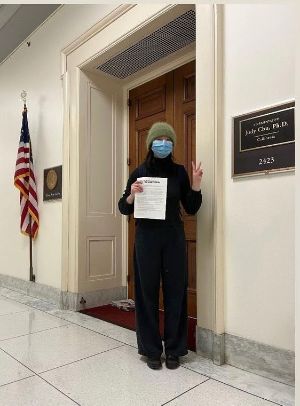Republished with permission from the ReconciliAsian newsletter.
On January 16, 2024, Lynn Hur participated in an outdoor peace vigil with about 200 Mennonites in front of the House of Representatives’ Cannon House Office Building in Washington D.C. Some 135 Mennonites and other interfaith allies also entered the Cannon Building and were arrested as they sang songs of peace and called on Congress to support a permanent ceasefire in Gaza and release of all hostages in the war between Hamas and Israel.

Lynn Hur
Lynn Hur is a graduate of University of California, Los Angeles, where she studied sociology and community engagement and social change. She is active with the Los Angeles Regional Collaborative for Climate Action and Sustainability, where she works on climate and public health communication. She is passionate and fascinated with the process of creating sustainable, equitable and creative public spaces with BIPOC and immigrant communities. She currently resides in Pasadena, California and is a member of Pasadena Mennonite Church.
I have a friend that lives in East Jerusalem, Palestine, with whom I have developed a deep friendship over the last few months. I clearly remember one conversation from the first time we met, as we sat outside and talked for hours. When she had finished telling the story of a particularly harrowing experience in her life, I asked, rather clumsily, “How do you stay sane?” Just as I started to regret asking, she finished taking a drag out of her cigarette and exhaled with the wisdom of a 23-year-old Palestinian woman: “You find people who grieve the same way you do.”
She and I paused, quietly sitting with that profound answer. The last few months have been a practice of profound grief for all of us. This grief mobilized me and other Mennonites from all over the United States to gather in Washington, D.C., with Mennonite Action [an independent grassroots organization] for a Day of Action for Gaza.
Monday, January 15: Training Day
12:30 p.m., National City Christian Church, Washington, D.C.
There are two things you must know about Mennonites: 1) Mennonites love to sing hymns in four-part harmonies, and 2) The Mennonite community is a small world.
“This is the most white people I’ve been around in a while,” I text my older brother after a long session of Mennonites solemnly putting their heads together to make sure the hymn singing will be in good shape tomorrow. All around, I see welcoming smiles, “Is that my cousin?” and “It feels like a family gathering!” It is heartwarming to see communities and congregations connect and reconnect, and yet it seems that many people do not know how to talk to me. In fact, hardly anyone has talked to me at all today.
Our training focuses on our personal motivations for participating in civil disobedience. I make small talk with an older woman who coolly explains, “I have nothing to lose—I might as well.” For many people, their motivation is that they are with their community, so they feel more secure and encouraged. But I am alone, very much a minority here, and feel very much like an outsider. By the time I have to decide, I realize that I don’t feel grounded enough to participate in civil disobedience and choose to support the cause in other ways.
Tuesday, January 16: Day of Action
10:30 a.m., Washington City Church of the Brethren, Washington, D.C.
In these overwhelmingly white spaces, I often find myself observing rather than reaching out – maybe because it is more comfortable for me. But I’ve realized recently that I am actually just waiting for someone to notice me. I am made comfortable with not being seen.
Perhaps people do notice. As we walk toward Capitol Hill, I see a few people give me a quick glance, a tight smile, a questioning look. A couple of people ask me how I had heard about this event, to which I respond, “I’m representing my Mennonite congregation.”
A young white woman abruptly asks if I grew up in the Mennonite church, to which I respond with a muted nod. These aren’t intentionally harmful questions, but they arise because they do not think I am one of them.

Provided by Mennonite Action
12:25 p.m., outside the Cannon House Building, Capitol Hill, Washington, D.C.
There are 150 Mennonites inside the Cannon House Building participating in civil disobedience, singing hymns as they get arrested by Capitol police.
Meanwhile, there are more than 200 of us outside, having our own peace service. Everyone quiets down, and despite the wind, we can hear faint singing from inside the Cannon House Building. As the arrested protesters are moved into police buses, we cheer and sing to them hymns of protection and peace. The atmosphere is filled with a sense of unity and solidarity as we stand together, transcending physical barriers. It went smoothly as expected: Mennonites and their preprepared plans and their blasted beautiful four part harmonies.
3:50 p.m., Representative Judy Chu’s Office, Rayburn House Building, Washington, D.C.
Office 2423 is far down the hall. We shuffle across the large, white corridor with quiet footsteps that echo through the chamber. As I pass each representative’s office and plaque, I see, pasted next to every one, a blue poster that indicates support for Israel. I reel at the sight of a Floridian representative’s office, flanked by a Thin Blue Line flag used by Blue Lives Matter supporters, a similar red one apparently in similar support for firefighters, alongside an American and Israeli flag.
We come to a stop at the office next door, Representative Judy Chu’s office. My community has gathered in front of her office in Pasadena, California, every Monday since the siege on Gaza began. While her office back home is hidden in a commercial strip next to a bank and ATM, this one is formidable and very official-looking. These people are so flagrantly powerful, I think lamely, as I drop off a petition for a ceasefire in their mail slot. It’s a bit of a late observation, but it’s all the more reason to move.
4:05 p.m., Rayburn House Cafeteria, Capitol Hill, Washington, D.C.
I rush downstairs to look for a quiet place to hop on call – a guard somewhere mentions a cafeteria – and book it to the rather drab cafeteria room, where a couple of fancy men in suits sit having a private discussion. My nose still numb from the biting cold, I frantically take notes for an agenda to meet my representative’s staffer, who technically should have been in the office upstairs but is in fact not there due to aforementioned cold. And yes, I do mention to them that I am calling from their workplace cafeteria hall and that I did, in fact, drop by their empty office about 15 minutes ago.

Lynn Hur dropping off petitions signed by over 5,000 Mennonites at Congresswoman Judy Chu’s office in Washington D.C.
Two people from my congregation back home, Bert and Santiago, join me to meet Judy Chu’s legislative director, David. David is, as Bert calls him, “a notetaker type of aide,” meaning he takes notes more than he talks. He is calm, not very responsive, and obviously tired of these meetings. In the moments where there is only the quiet clicking of his typing, I try to picture how the notes he takes actually fill a page. I imagine just a few sentences: a quick description of us, our ask to recognize Israel’s intent for genocide in her call for a ceasefire. To do more, to build momentum, et cetera. It’s not enough, I fume. When will there be enough? What else can we do but keep going?
Wednesday, January 17
1:45 p.m., Smithsonian National Museum of Art and Portraiture, Presidential Portraits Exhibit, Washington, D.C.
The last thing I do before I leave Washington is visit the Smithsonian’s Presidential Portraits exhibit. As I face a room full of glorified war criminals staring back at me, I feel a churning feeling in my stomach – the bitterness of our history and legacy of electoral politics, of a bureaucracy dedicated to the agenda of genocide as a Western imperialist strategy.
Grief transforms into resolve as I stand in front of the portraits of these 54 presidents, as I walk the formidable white halls of powerful politicians, as I speak to their tired aides, and as I realize the stark barriers within my own faith community.
What does it mean to “find people who grieve the same way you do”? To me, it means that my grief cannot stay here, welling at the pit of my stomach; it must be carried together and transformed into action.
It means I must participate in a reconciliation between myself and my community to do the good work. It means I must choose to place my grief with them for renewed energy to take action.

